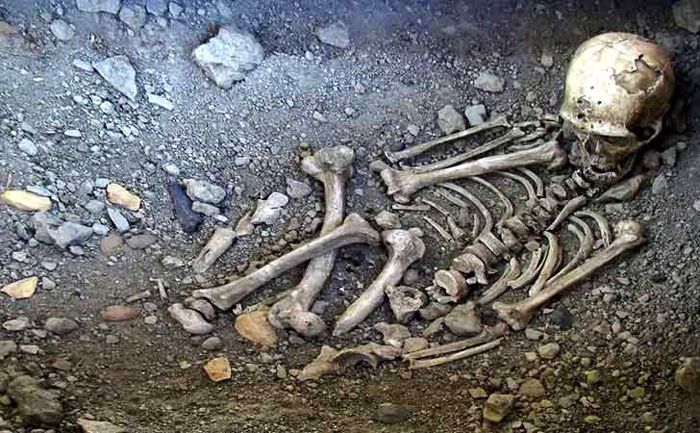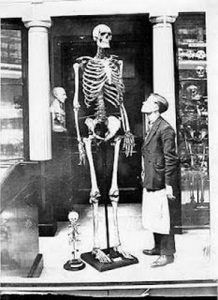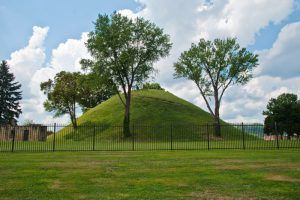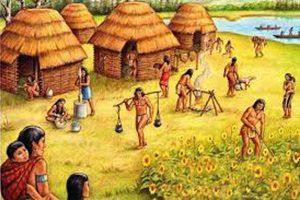“On the earth, there once were giants.” — Homer, Greek poet, 400 B.C.
In many of the ancient burial mounds of West Virginia, several “giants” were found in years past. Other large skeletons were found in the early days of coal mining, and more were found as people were excavating the ground for other purposes.
One of the first reports of a giant occurred in 1774 when Jack Parsons was walking along the recently flooded Cheat River. When he noticed some bones protruding from the ground, he pulled a femur from the soil, and when he compared it to his own, it was seven inches longer. He then removed the rest of the bones and laid them out, estimating that it would have stood about eight feet tall. Other settlers also found gigantic skeletons in the area, which was soon dubbed “Giant Town.”
In 1838, when amateurs excavated the Grave Creek Mound in present-day Moundsville, West Virginia., they were said to have found giant human skeletons inside that were as long as eight feet.
In the 1850s, a root cellar was being dug in Palatine (East Fairmont), West Virginia. Here, workers uncovered two very large human skeletons, said to have been more than seven feet tall. Several people saw the skeletons, but that night, the bones were stolen, assumed to be sold on in the lucrative market of “Indian relics,” which existed at the time.
In 1857, the Western Literary Messenger reported that the skeleton of a giant had been found, stating:
“A day or two since, some workman engaged in subsoiling the grounds of Sheriff Wickham, at his vineyard in East Wheeling, came across a human skeleton. Although much decayed, there was little difficulty in identifying it by placing the bones, which could not have had belonged to other than a human body, in their original position. The impression made from the skeleton itself was measured by the Sheriff and a brother in the craft locale, both of whom were prepared to swear that it was 10 feet, 9 inches in length. Its jaws and teeth were almost as large as those of a horse. The bones are to be seen at the Sheriff’s office.”
In 1875, when workers were constructing a bridge near Paw Paw Creek’s mouth at Rivesville, they uncovered three giant skeletons with strands of reddish hair clinging to their skulls. A local doctor was called to examine the remains, who determined that they were human and estimated that the skeletons were approximately eight feet tall. Afterward, with exposure to the air, the bones deteriorated rapidly.
In 1882, amateur archaeologists F.M. Fetty and his wife were exploring an unusual rock formation along White Day Creek in Marion County when they found what appeared to be a shelter. On closer examination, they discovered that a false wall had been erected, and after removing several large stones, they found a huge ancient mummy sitting in a chair. The giant was surrounded by stone and flint artifacts.
In the summer of 1883, James A. Faulkner unearthed a gigantic human skeleton in the same area. Dr. Samuel Kramer of Smithtown was called in and measured this skeleton, which was found to be 7 feet 4 inches long, and deduced that it belonged to a person who was almost eight feet tall.
That same year, the Smithsonian Institution dispatched a team of archaeologists to the Criel Mound in South Charleston. Led by Colonel Lewis Morris, the team conducted extensive digs of some 50 mounds in the area and issued a detailed report.
In their investigation, the team uncovered numerous giants, one of which was 7’6″ tall and decorated with six heavy copper bracelets on each wrist, and on his shoulder were three large plates of mica. In another mound, they found a circle of ten skeletons surrounding a giant skeleton, as well as underground vaults, various copper and mica ornaments, jewelry, religious items, pipes, and spearheads. Another giant skeleton was also found that had a “flat-head” type skull.
As more digs progressed in the coming years, archaeologists in Wheeling, West Virginia, found another grouping of giants ranging in height from 6’7″ to 7’6″, displaying unusual skull formations with low foreheads and prominent backs of the skull.
As similar discoveries were unearthed, the Charleston Daily Mail published an article in October 1922 that stated:
“One of the most interesting of the five state parks is Mound Park, at Moundsville from which that city derived its name. Probably no other relic of pre-historic origin has attracted a wide study among archaeologists as the Grave Creek Mound, which has given up skeletons of the ancients who constructed it… Some years ago, archaeologists investigating the mound dug out a skeleton said to be that of a female because of the formation of the bones. The skeleton was seven feet four inches tall, and the jawbone would easily fit over the face of a man weighing 160 pounds.”
In June 1930, the Clarksburg Sunday Exponent reported:
“Interesting and valuable evidence of a race of gigantic people who inhabited this section of West Virginia more than one thousand years ago have been exhumed from two newly explored mounds located near Morgansville, which is on the Northwestern turnpike about 12 miles west of Salem.
The particular tribe or race which inhabited this section of the state is believed to have been composed of individuals ranging from seven to nine feet in height, and it is thought they were Siouan Indians. The best-preserved skeleton found at Morgansville was in a clay encasement, and all of the vertebrae and other bones, excepting the skull, were saved without much crumbling. Careful measurement of the skeletons proved that the Indians were about seven feet, six inches tall.”
This was in response to Professor Ernest Sutton, the head of the Geography Department at Salem College, having excavated two mounds in Doddridge County, in which he uncovered four skeletons.
The most recent discovery of these giants was made in 1959 when Dr. Donald Dragoo, the curator for the Section of Man at the Carnegie Museum, excavated the Cresap Mound in Marshall County. There, he unearthed a 7 feet 2-inch skeleton.
Tales of colossal giants permeate American History, not only in West Virginia but across the continent. These many finds in America and the rest of the world support the idea that giants once walked on earth centuries ago and are more than just mythological beings.
©Kathy Weiser-Alexander/Legends of America, updated October 2021.
Also See:
The Adena Culture of the Northeast
Legends, Ghosts, Myths & Mysteries
Sources:
Ancient Origins
Appalachian Magazine
Bureau of Ethnology, Annual Report of the to the Smithsonian Institute, Volume 5, 1883-1884
Genesis Giants
Graham Hancock
Jabajabba-Question Everything
Michaels, Denver; Wild & Wonderful (and Paranormal) West Virginia, 2017





